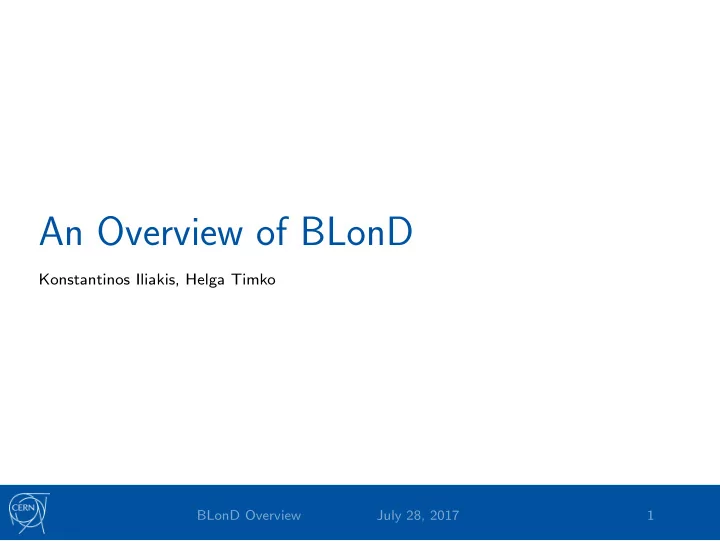

An Overview of BLonD Konstantinos Iliakis, Helga Timko BLonD Overview July 28, 2017 1
Why do we need beam modeling? • Better machine design • Control and manipulate the beam (splitting, shaping etc) − PSB 1 bunch, LHC: 2808 bunches • To ensure beam quality and safe operation • Beam instabilities can lead to − Deterioration of beam quality, loss of luminosity − Beam losses that result in radiation and safety issues • Older machines operate outside of originally designed specifications BLonD Overview July 28, 2017 2
Motivation for a Beam Dynamics Code • Existing codes are not well maintained or reliable • CERNs increasing need for more accurate predictions − Simple models do not fit the observations due to the increased bunch intensity − Precise bunch distribution, impedance modeling, beam control BLonD Overview July 28, 2017 3
• Beam Longitudinal Dynamics simulator 1 • A simulation is composed of a pipeline of physics modules. • BLonD is written in Python with C/C++ extensions for the computational kernels. • Important conclusions drawn using BLonD can be found in the literature 234 . 1http://blond.web.cerh.ch, https://github.com/blond-admin/BLonD 2Helga Timko et al. “Studies on Controlled RF Noise for the LHC”. In: 54th ICFA Advanced Beam Dynamics Workshop on High-Intensity, High Brightness and High Power Hadron beams, East-Lansing, USA (2015). 3Helga Timko et al. “Benchmarking the Beam Longitudinal Dynamics Code BLonD”. In: 7th International Particle Accelerator Conference, Busan, Korea (2016). 4Alexandre Lasheen et al. “Synchrotron frequency shift as a probe of the CERN SPS reactive impedance”. In: 54th ICFA Advanced Beam Dynamics Workshop on High-Intensity, High Brightness and High Power Hadron beams, East-Lansing, USA (2015). BLonD Overview July 28, 2017 4
Synchrotron Model • RF stations • Magnetic arcs • Intensity effects BLonD Overview July 28, 2017 5
Features and Usability of BLonD Features Usability • Single/ Multi-bunch options • Match / explain experimental • Acceleration, Multiple RF observations systems and RF stations • Make accurate predictions/ • Collective effects cross-check with measurements • Trace down the source of • Beam based/ cavity based limitations/ instabilities feedbacks • Guide decisions for machine • Multi-turn effects upgrades and predict beam • Monitoring, plotting, data behavior analysis BLonD Overview July 28, 2017 6
A Typical BLonD Simulation Particle tracking Sliced tracking • Vector-vector operations • Modeling interactions between particles and machine • Transformations applied to all (impedance, feedbacks) particles • Well know algorithms used: • Up to 100M currently • Histogram • x10 increase is foreseen • FFT • Multi-bunch simulations • Convolution • Up to 72 bunches for SPS • Impedance dictates frequency but 288 are needed resolution which defines #bins • 1000s of bunches for the • Future machines (FCCee) will LHC increase radically the #bins BLonD Overview July 28, 2017 7
Present Computational Challenges • Large number of particles is required to provide sufficient frequency resolution for impedance calculation and avoid numerical noise in space charge simulations • Three different types of time consuming simulations: • SPS ramp with 72 bunches and intensity effects (1 day) • LHC ramp with feedbacks, emittance blow-up, few bunches (1 week) • PSB ramp with intensity effects, multi-turn wake, feedbacks, emittance blow-up and periodicity • Parameter scans: thousands of small/medium sized simulations BLonD Overview July 28, 2017 8
Thank you for your attention BLonD Overview July 28, 2017 9
Recommend
More recommend